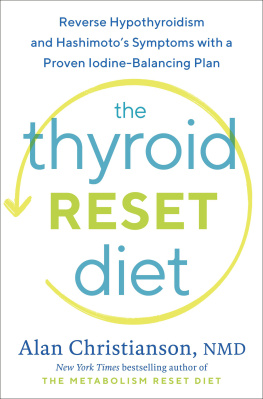Eric Christianson - Perils of Polypharmacy
Here you can read online Eric Christianson - Perils of Polypharmacy full text of the book (entire story) in english for free. Download pdf and epub, get meaning, cover and reviews about this ebook. year: 2021, publisher: Med Ed 101, Inc., genre: Home and family. Description of the work, (preface) as well as reviews are available. Best literature library LitArk.com created for fans of good reading and offers a wide selection of genres:
Romance novel
Science fiction
Adventure
Detective
Science
History
Home and family
Prose
Art
Politics
Computer
Non-fiction
Religion
Business
Children
Humor
Choose a favorite category and find really read worthwhile books. Enjoy immersion in the world of imagination, feel the emotions of the characters or learn something new for yourself, make an fascinating discovery.
- Book:Perils of Polypharmacy
- Author:
- Publisher:Med Ed 101, Inc.
- Genre:
- Year:2021
- Rating:3 / 5
- Favourites:Add to favourites
- Your mark:
- 60
- 1
- 2
- 3
- 4
- 5
Perils of Polypharmacy: summary, description and annotation
We offer to read an annotation, description, summary or preface (depends on what the author of the book "Perils of Polypharmacy" wrote himself). If you haven't found the necessary information about the book — write in the comments, we will try to find it.
Perils of Polypharmacy — read online for free the complete book (whole text) full work
Below is the text of the book, divided by pages. System saving the place of the last page read, allows you to conveniently read the book "Perils of Polypharmacy" online for free, without having to search again every time where you left off. Put a bookmark, and you can go to the page where you finished reading at any time.
Font size:
Interval:
Bookmark:
Author: Dr. Eric Christianson, PharmD, BCPS, BCGP
Editor: Jennifer Salling
Cover Illustration: Kate Smith
Copyright 2021 by Eric Christianson, Pharm.D., BCPS, BCGP
All rights reserved. No part of this book may be reproduced or transmitted in any form or by any means without written permission of the author.
Table of Contents
All rights reserved. It is not permitted to reproduce, distribute, or transmit in any form or by any means the content in this book without the written permission of the publisher except in the case of brief quotations as allowed by copyright law.
This book is for educational purposes only. It is not intended to diagnose, treat or be construed as medical advice in anyway. This book is not intended as a substitute for sound medical advice from a pharmacist, physician, nurse, or other qualified healthcare professional. Please consult the appropriate healthcare professional in matters relating to your health and any symptom that may require diagnosis, treatment, or medical attention.
The author has made every effort to make sure the information in this book is correct at time of release. However, the author and publisher do not assume and hereby disclaim any liability to any party for loss, damage, or disruption caused by any errors or omissions in this book. Whether the errors or omissions were a result of negligence, accident, or any other cause, the author does not assume and hereby disclaims liability.
Editing by Jennifer Salling
Cover Illustration and Design Copyright 2021 by Kate Smith
Formatting by Melissa Christianson
Copyright Eric Christianson 2021
Some of the latest research estimates that 67% of geriatric patients take 5 medications or more. Millions of patients are stuck in the polypharmacy rut. While many medications are necessary and life-saving, Ive made it my lifes work (15+ years) to try to optimize and ideally reduce the number of medications that patients are taking. I have a deep appreciation for how adding more medication can lead to frustrated patients, worse outcomes, adverse effects, drug interactions, more frequent clinic visits, and hospitalizations.
New medications can unknowingly cause adverse effects that prompt new diagnoses and new prescriptions to manage those adverse effects. What the patient is left with is a vicious cycle called the prescribing cascade that leads to more medication, worsening health, and a feeling of helplessness that they will be taking several medications for the rest of their life.
I designed this book to help healthcare professionals identify the prescribing cascade and the collateral damage that can result on account of polypharmacy. Throughout the book, I provide countless case examples of common adverse effects, the prescribing cascade, and complications resulting from polypharmacy. I have included examples of over 200 of the most commonly prescribed medications.
Ultimately, this book will help you recognize polypharmacy, the prescribing cascade, and more importantly, give you actionable situations, case scenarios, and ideas to help reduce medications in your patients.
I work with patients, nurses, doctors, pharmacists and other healthcare professionals everyday who struggle with medication management. One of the biggest problems I run into is polypharmacy which is the use of multiple medications in an individual patient. Ten, twenty, and sometimes up to 30+ medications is something I come across on a daily basis. Throughout this book I provide case scenarios and examples of how polypharmacy is problematic.
Ive created the 10 commandments of polypharmacy to help you identify ways to help reduce the medication burden of our patients.
- Thou shalt not start, ask for, dispense, or administer a medication without reviewing a medication list that is accurate, up to date, and complete with over-the-counter medications and supplements
- Thou shalt consider utilizing non-drug approaches and interventions to solve patient problems before initiating medication
- Thou shalt assess if a medication is effective before adding a new medication for the same condition
- Thou shalt consider any new symptom is an adverse effect of another medication until proved otherwise
- Thou shalt not start a medication without an appropriate indication and assessing appropriate lab work
- Thou shalt identify limits for medications not intended for chronic use as well as not continue a medication indefinitely for symptoms that have an expected short duration
- Thou shalt not start a medication from a similar medication class without appropriate rationale
- Thou shalt not initiate a medication without considering medications that may treat duplicate conditions
- Thou shalt consider eliminating or reducing medications at every medication review
- Thou shalt be willing to accept risk in discontinuing a medication if they were willing to accept the risk of initiating a medication
In addition to recognizing problems with polypharmacy, I also address the prescribing cascade. Healthcare professionals who do not have a great understanding of geriatrics and pharmacotherapy can inadvertently misdiagnose patients with new conditions when new symptoms are actually adverse effects of current therapy. The prescribing cascade happens when a patient begins a new medication to treat an adverse effect from another medication. In some situations, this can be done intentionally. More often than I would like, it is unintentionally done and is a major contributor to polypharmacy.
I have been trained to consider a new symptom a side effect of medication(s) that the patient is currently taking until proven otherwise. In this book, I will try to train your mind to think that way with countless examples that I have seen in my practice. I will even go one step further than that and help you understand that any new medication that is started should be considered part of the prescribing cascade until proven otherwise. I have covered the most common polypharmacy concerns of the top 200 medications and a few others that are relevant in my practice. I hope you find that this book is a useful resource to help you stop polypharmacy.
Calcium Channel Blockers are among some of the most commonly used agents for hypertension. The dihydropyridines are at the top of the list with the most commonly used agent Ive seen in practice being amlodipine (Norvasc). Other somewhat common agents include felodipine (Plendil) and nifedipine (Adalat, Procardia).
Edema is a concern with these agents and I have seen this adverse effect lead to the prescribing cascade numerous times. In a patient who is experiencing swelling in their extremities, you must review the medication list and identify if a calcium channel blocker has recently been started or increased. Ive seen plenty of anecdotal cases to support this adverse effect, but there is also plenty of literature to back it up.
A study by Savage et al. looked at over 40,000 patients and compared the frequency of diuretic prescriptions in patients who were started on a calcium channel blocker and those who didnt start a CCB. There was a significant increase in the number of patients who were placed on diuretics following initiation of a calcium channel blocker.
If you are dispensing or prescribing a diuretic for a patient, please take a look and see if a calcium channel blocker has recently been started. In addition to not only starting this drug, recall that edema is typically a dose-dependent effect. Dose increases of a calcium channel blocker may also be the cause for a diuretic prescription.
Font size:
Interval:
Bookmark:
Similar books «Perils of Polypharmacy»
Look at similar books to Perils of Polypharmacy. We have selected literature similar in name and meaning in the hope of providing readers with more options to find new, interesting, not yet read works.
Discussion, reviews of the book Perils of Polypharmacy and just readers' own opinions. Leave your comments, write what you think about the work, its meaning or the main characters. Specify what exactly you liked and what you didn't like, and why you think so.









